tribes ii
Photo Matson Collection
.png)
Shammar
The Shammar, the second largest Bedouin group of Arabia, are Southern Arabs (Tai) with roots in Yemen. They were first mentioned in the 14th century. Their home was the Djebel Shammar in Northern Saudi Arabia.


_JPG.jpg)
Hajr Abu Wuded, Sheikh of the Feddaga Shammar, 1911, (Oppenheim, left), Sheikh Sukheil of the Zagarit Shammar in Ukheidir, Iraq (Getrude Bell, middle) and Abeyah 1896, a Abeyyah Sharakiyah bred by Mit´ab al-Habd of al-Thabit section of Shammar (right), imported to America for Homer Davenport.
Like the Anaza a large part of the Shammar migrated towards the North in the 17th century under the leadership of al-Jerba, but first only as far as today´s Southern Iraq. They were forced to cross the Euphrates in 1800 by the Wahhabite attacks, and their sheikh Fares, founder of the house of al Jerba/Djerba, could win influence with the Ottoman Wali in Baghdad and became their Bab Al Arab. At the same time he beat the then ruling tribe of the Jezireh, the Obed, and forced them to retreat and fall into oblivion. With Said Pasha as new Wali the mighty Muntafiq tribe was preferred by the government after 1813, and the Shammar became feared opponents of the Turks. Later with Fares´s son Sefuk/Sefuq, the Shammar became allies of the Ottoman pasha again and could soon be found as far north as Mosul. The Northern Shammar ruled the Jezireh, the land between Euphrates and Tigris during most of the 19th century, and were later divided between the East-Shammar around Ferhan and the West-Shammar around Faris/Fares. In the 1870´ s Sheikh Abd al Karim al-Jarba, father of Faris and leader of the Northern Shammar, led a bloody rebellion against the Ottoman Wali in Baghdad. The Turks quelled the rebellion, hang Abd al Karim on a bridge in Mosul, Iraq, in 1875 and put his half brother Farhan in charge of the Shammar of the North, prompting Abd Al Karim´s mother, Ameeh al-Husayn, daughter of Husayn al Assaf, sheikh of the Tayy, to flee the Jezireh area of Mesopotamia with her young son Faris, and seek refuge with Ibn Rasheed in Hail, the leader of the Shammar of the South. Sheikh Faris al Jerba could later win leadership of the Western Shammar in Iraq and was blood brother to Wilfried Blunt. He could obtain the title of a Pasha from the Turks, like his opponent Farhan. Today the Northern Shammar in Iraq are also called Shammar al Jerba and are Sunni. After the Ottoman influence the British and French and the newly established frontiers led to a further division of the Shammar in an Iraqi (Shammar Khorsa) and a Syrian part (Shammar az Zor). The southern branch of the Iraqi Shammar are called Shammar Toga and belong to the Shiits.
From the Shammar who remained in the South emerged the Emirate of Ibn Rasheed at Hail (1838 - 1921). There is a own chapter following on the house of Rasheed/Rashid. According to the British Handbook of Arabia of 1920 the Shammar were estimated to have 4,000 tents or 150,000-200,000 people which constituted the Shammar qabila/gabila. According to Shammar genealogies they are divided into four tribal sections called ashair (singular ashira): Aslam (1,200 tents), Sinjara (1,000 tents), Abde (1,500 tents) and Tuman (300 tents). Those sections claimed descent from one apical ancestor and shared a defined territory whose resources pasture, water and oases, were divided among them. The Abde Shammar used land between Jebel Aja and Jebel Salma (south and southeast of Hail), whereas the Aslam camped to the east of the Abde. Sinjara inhabited the central part of the Great Nafud Desert (Rasheed).

.jpg)
.jpg)
Photos by Gertrude Bell: Shammar woman and child on camel and horses (left), Iraq (middle), and Serin Tower, Iraq 1909 (right)
The southern branch of the Iraqi Shammar are called Shammar Toga and belong to the Shiits. From the Shammar who remained in the South emerged the Emirate of Ibn Rasheed at Hail (1838 - 1921). There is a own chapter following on the house of Rasheed/Rashid. According to the British Handbook of Arabia of 1920 the Shammar were estimated to have 4,000 tents or 150,000-200,000 people which constituted the Shammar qabila/gabila. According to Shammar genealogies they are divided into four tribal sections called ashair (singular ashira): Aslam (1,200 tents), Sinjara (1,000 tents), Abde (1,500 tents) and Tuman (300 tents). Those sections claimed descent from one apical ancestor and shared a defined territory whose resources pasture, water and oases, were divided among them. The Abde Shammar used land between Jebel Aja and Jebel Salma (south and southeast of Hail), whereas the Aslam camped to the east of the Abde. Sinjara inhabited the central part of the Great Nafud Desert (Rasheed). Until 1836 the Shammar tribe had no single chief or head, after this date the Ibn Rasheeds took lead, who belonged to the Abde/Abdah branch. Today Shammar people can be found in Iraq, Saudi Arabia, Kuwait, Syria, Lebanon and Jordan.
In the 18th century the nearest markets were in Iraq or on the Persian Gulf (for export to India), because the Anaza blocked the way to Syria. This may explain why not many Shammar-bred horses are found among the ancestors of our horses, although the Shammar were renowned horse breeders. Oppenheim writes: "The sale of horses - in the 1840s to Egypt, later to India - was a big source of income." Guarmani reports that in the pastures of Jebel Shammar near Hail in 1863 500 mares were grazing under the protection of 300 slaves. Only two foundation horses in Egyptian breeding came directly from the Shammar, one of them the influential mare Venus who founded the Egyptian Hadban Enzahi strain which produced Nazeer. Her name is derived from her breeder, the Yunis (Venus) clan of the Zauba/Zoba - Shammar (Raswan), but we can not discern if from the northern or southern Shammar because we find a Zauba/Zoba clan in both. Mashaan, a bay desert bred racing stallion born c.1925, a Kuhailan ´Ajuz, imported to Egypt prior to 1928, and leased to the RAS for one season, is said to come from the Shammar near Deyr az Zor. Another infusion of Shammar blood, but also with little influence in Egyptian lines, came through another race horse, El Nasser 1938, whose sire was a Dahman stallion of the al Ajarash clan of the Shammar in Syria. Also El Deree c.1920, though bred by Cheder al-Deri of the Baqqara, is of Shammar origin, as his breeder had obtained his horses originally from the Shammar. On the other hand six of the horses imported to America for Davenport came from the Shammar: Hadbah 1900, Jedah 1902, Urfah 1898, Hamrah 1904, Haffia 1906, Abeyah 1896. Also in the last quarter of the 20th century a mare found its way to Germany, bred by the Shammar Bedouins near Hail in Saudi Arabia: Gazala 1967, a bay Hamdaniah. According to Al Dahdah the house of Jarba had at least four contemporary “Sheykhs of the Shammar” in the 20th century. Each of them was famous for one strain of Arabian horses: Mayzar Abd al-Mushin al-Jarba bred the marbat of Kuhaylan Krush. Mashaal Pasha, son of Faris al-Jarba and head of the Shammar az-Zor near Deyr az Zor in Syria, had Shuwayman Sabba horses. And Dham al-Hadi, leader of the Iraqi Shammar, a descendant of Farhan, was reknowned for Hadban Enzahi. Ajil al-Yawir al-Jarba, who followed Dham al-Hadi after his expulsion from Iraq, was famous for his Saqlawi Jadran strain.
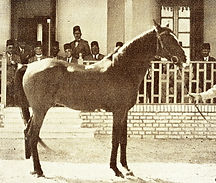


Stallion Mashaan in Egypt (left), mare Gazala in Geramany (Ursula Guttmann photo, middle), and a photo by Gertrude Bell: crossing the Euphrates, 1911
The Tai
The Tai tribe in today Syria and also Iraq is the remaining population of one of the oldest Arabian people from which the Shammar and numerous other tribes, like the Dawasir in Saudi Arabia, but also the Fadl and Muhanna, are descended from. One of their ancestors is Hatem Tai, an Arabic "national" hero and poet living at the turn of the 6th century AD. Their origin is Southern Arabia from where they migrated north, first to the Jebel Shammar, at those times in the Middle Ages called Jebel Tai. Many of the Tai clans have later merged into other tribes. Only the Mesopotamian Tai retained their original name (Oppenheim).
One historic account relates of the Tai´s connection with horses: At the end of 1623, after Shah Abbas the Great had conquered Iraq, 100 Tai riders went off for a ghazzu into Persia and returned home to their tents near Mardin with 200 dromedaries and a fair number of quality horses. Rzewuski gives 10,000 tents for the Beni Tai tribe under its sheikh Tamer Salum (1819). He also incorporated a drawing of a horse of the Tai into his famous manuscript. At the beginning of the 19th century the Tai were split into two parts by the invading Shammar. One part remained in the area of Sindjar, the other crossed the Tigris and settled near Erbil to live a half nomadic life. Later the Tai were closely connected with the Shammar through marriage between the sheikh families.
Regarding Arabian horses none was exported to the West to the author´s knowledge. Nevertheless the Tai are among the horse breeding tribes in modern Syria and had a high reputation for their asil Arabians in the years before the horrible civil war began.
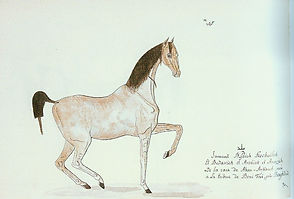

In the tent of Abu Tai (Gertrude Bell, left). Right: drawing by Count Rzewuski of a horse of the Tai in his famous manuscript, ca.1818.


Horses of the Tai tribe in Syria during WAHO conference 2007, photos by Karin Weirich
Al Jibur
The Jibur (Djebur, Jabouri) belong to the smaller tribes of Mesopotamia. Like a large part of the Bedouin population of Mesopotamia and the neighboring North Syrian and Iraqi areas, the Jiburi were part of the Zubed, who originated from the Southern Arabian Zubed and had come into the North as early as 1200. (Jibur, Dulaym, Janabi and ´Ubadi federations are subgroups of the Zubaydi tribe originating in Yemen). The Jibur immigrated during the 14th century and moved even further during the great Bedouin migrations of the 18th and early 19th century, until some of them found a new home on the Chabur, a tributary of the Euphrates, near Deyr Ez Zor, and others on the Tigris north of Tikrit. The first group were warlike semi-nomads who moved to the Syrian steppes in winter. They were not subject to the Shammar, whom they had defeated in battle in 1913 (Oppenheim). The sire of El Nasser (Didane, 1938) was a Dahman Amer bred by the al-Ajarrash family of the Shammar (El Dahdah information) and came into the possession of the Jibur tribe. The Jibur of the Tigris soon settled down and paid tribute to the Shammar. According to Lady Blunt they bred water buffalos.


Sheikh Ashkar of Jibur, photo Gertrude Bell 1909, right: Iraq 1911 (Gertrude Bell)

Meslat Pasha and his family, grand Sheikh of al-Jibur (Oppenheim)
Al Aqaydat
Al Aqaydad or Al Agidad (El Ogedat) were a small warlike tribe in Syria and their winter quarters lay west of Deyr Ez Zor, where they had come around 1860 after splitting from the Agidad of the Euphrates. By the 1930s about two third of them had settled down. The nomadic part accompanied the Mawali on their winter migration. According to Lady Anne the Agidad were not well regarded, but owned a few good mares which they had from the Anaza, and they were enthusiastic breeders. From this tribe we have an exact account of their livestock as of 1934: 100-150 camels, 4,000 sheep, 30 horses, 100 mules and 200 donkeys. From the Al Agidad tribe the stallion Nabras c.1920, a Hadban Enzahi, comes.

Stallion Nabras, a racing stallion from Syria in Egypt and used at the RAS as breeding stallion.
Al Baqqara
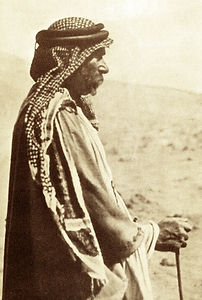
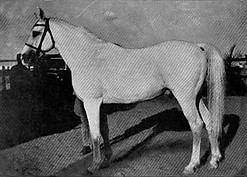

Stallion El Deree in Egypt
Sheikh Es´ad el Besheer of Baqqarat el Zor, photo Oppenheim 1924
Tribes that are called Baqqara/Baggara can be found today in Syria, Iraq, Israel and also in Sudan. Baqqara can be translated "cattle herdsman". Regarding the history of Arabian horses we will only look at the Baqqara of Syria. Those Syrian Baqqara are mostly found today in the area of Deyr Ez Zor/Zour in northeast Syria. In fact the Baqqara are the largest tribal federation in this area today, numbering some 1,2 million people. Oppenheim (in the 1920s) gives the following details: The Baqqara have only a poor historic tradition, but they surely inhabited the area they lived in for centuries. Tradition has it that their ancestor came from the Hedjaz and that his grave is at Deyr Ez Zor (some even give the fifth Imam of the Shiits, Muhammed El Baker, as this man). At the beginning 20th century the Baqqara were divided in two main groups: the Baqqarat el Djebel and the Baqqarat El Zor, the latter with their main sheikh from the family El Besheer. Both have been semi nomads going out into the steppe in wintertime with their large herds of camels and sheep. The Baqqara of Syria did not have cattle at that time, different to the Baqqara of Sudan where profession and name was the same. So it may well be that in Syria the name Baqqara is not derived from "cattle herdsman" but from a person´s name: a sheikh Bagger who has a saint´s grave in Djebel Abd el Aziz in northeast Syria. The Baqqara lived in harmony with most of their neighbors and even a part of the tribe had themselves connected to the Jiburi or Milli tribes. Also the Ogedat inhabited the same area as the Baqqara. The Anaza on the other hand were enemies and ghazus were performed until the beginning 20th century. Most of the Baqqarat had to pay a small chuwe to the family of el ´Amr of the Shammar.
The Baqqara were and are still today breeders of asil Arabians. Jens Sannek describes his visit to Sheikh Nawaf Ragheb Basheer and Sheikh Jasem Al Basheer in his book Desert Legacy. He was also told by the sheikhs the story of the origin of the stallion El Deree ca. 1920, influential foundation sire for Inshass. El Deree was bred by the Al Deri family of the Baqqara. A son of El Deree´s breeder lives in Germany for many years now: Dr. Ahmed Al Deri, born 1943 at El Hasakah, Syria, studied medicine in Germany and stayed to work as a doctor. He lives not far from the author´s place and we had the opportunity and pleasure to meet him and talk to him about his father and his horses. Here is Dr. Al Deri´s account: His father Cheder Al Deri was born in 1885 or 86. He was a most remarkable man and head of the Al Deri clan (numbering today 1,500 members). Cheder Al Deri still lived as semi nomad. Nearly the whole clan followed their herds of camels and sheep after the first rain, only to come back in summer. They lived along the river Chabur. Sheikh Cheder Al Deri was a man of foresight and saw that there was no future for this kind of living. So he began to buy land and engaged a teacher from Deyr Ez Zor. This man had to come along with the clan even during their wanderings. His tent was erected in the middle of all tents and he had to teach all members of the clan under 50 years to learn reading and writing. With those who were not willing Sheikh Cheder "used the stick." Of the 13 children of the sheikh nearly all went to university. Dr. Al Deri remembers that the family owned more than 200 camels and about 50 horses when he was a schoolboy. His father owned two lines of horses: Saqlawi Saifi and Dahman Amir. The Dahman horses were smaller and heavier. It was said that the Dahmans bring good luck to their owner´s family. On the other hand the Saqlawi Saifi were more elegant, had long lines and were good for racing. His father had been able to obtain his horses from the Shammar because of the high respect he had gained. Especially the Saqlawi horses of his father were famous and sought after. During a visit of General Charles D`Gaulle to Deyr Ez Zor, a show and a race for Arabian horses was held in his honor. Both were won by the horses of Cheder Al Deri. Other strains in the possession of the Al Deri clan have been Hamdani, Muniqui and Krush. Also Dr. Al Deri recalled the visits of horse dealers. They came to buy horses for the race track at Beyrouth. One of those horse dealers had the name Nahas. To him his father gave the stallion later known as El Deree. The stallion came to Beyrouth and was sent from there to Egypt for King Fuad. After a successful racing career he became head sire for the Royal Studfarm Inshass and was later given to the RAS.
Al Muntafiq
The Muntafiq/Muntefiq were one of the most important tribes in Iraq and lived along the lower Euphrates. For a long time they controlled the lower Euphrates and Tigris down to the Shatt El Arab. They emerged at the beginning 19th century when many Bedouin tribes along the lower Euphrates concluded a truce amongst themselves and united under the name of al-Muntafiq. They were very warlike and famous as horse breeders. Their leading family were the Sa´duns. Sheikh Messhara Ibn Sa´dun (Mischari Ibn Saadoun) bred the stallion Saadun, owned by Lady Blunt of Sheikh Obeyd in Egypt, one of the many examples of desert horses that were named after their breeders.
The Muntafiq are divided in three main branches: Bani Malik, al-Ajwad and Bani Sa´id. During Ottoman era the Muntafiq were close allies of the Turks. They had a bitter rivalry with the Shammar. In the second half of the 19th century most of the tribe settled into sedentary life and took up agriculture. The Muntafiq also converted to Shia. Those who remained Bedouin became mostly herders of small animals such as sheep and goat, rather than camels, and this made them less mobile and less competent as a fighting force compared with the camel-herding tribes of Inner Arabia or the Anaza and Shammar tribes. The town Nasiriya is named after one of the tribe´s sheiks and the surrounding province was known as Al-Muntafiq Province.
During World War I the Muntafiq fought with the Turks against the British. In the battle of Sche´be in April 1915, almost the entire army, including the horses, was cut down by the British cannons and machine guns. Most of Turkey´s foundation horses came from al Muntafiq, but also the ruler of Bahrain and Al Saud received gift horses from the Muntafiq sheikhs (Forbis, Philby).
.jpg)

Said Muhammad, mosque dome, view from Khan (Gertrude Bell 1909), stallion Saadun at Sheikh Obeyd, Egypt with Mutlak Ibn Batal, Mutair Bedouin stud manager for Lady Anne Blunt.


Foundation horses of Turkey: Matra 1927, a Maneki mare, and Seklavi 1924, a Seklavi Ucrefi stallion, both acquired at Baghdad.
Bani Sakhr
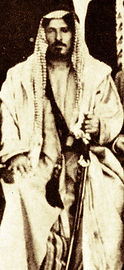

Sheikh Feny al Faiz, left, and Sotamm Al Kreish 1883, Saqlawi Jedran stallion bred by the Bani Sakhr, exported to Russia for Count Stroganov.
The tribe of the Bani Sakhr/Beni Sakhr/Banu Sakhr/Beni Sachr/Al Suchur is the largest former camel herding tribe in today Jordan. The tribe lived in the Hejaz since the beginning Middle Ages. They began to move north in about the early sixteenth century, around the same time as the Anaza did: the Beni Sakhr in the west and the Anaza in the eastern deserts. By the second half of the 18th century they finally established themselves in the Jordanian desert in the regions that used to control the pilgrimage route, coming in conflict with the predominant Sardije tribe, the former masters of the Jordanian desert who had to pay khuwa/chuwe/pl. khuwara. In summer they crossed the Jordan and in winter went south as far as the Tubaiq. At the end of the eighteenth century, after attacking the pilgrims and plundering them, the amir al Hadj, the pasha of Damascus, could hardly escape. The Ottomans intervened. The amir of Gaza mounted a campaign against the Bani Sakhr and killed many of them, seized their camels and horses, so they returned to the Balqa. Later the Bani Sakhr fought the Anaza when they emerged from Nejd.
In their best times the Beni Sakhr were said to be able to set out for battle with 3.000 armed warriors. Rzweuski gives 5,800 tents and Mutlak ibn Selameh as sheikh from the Beni Saher. Later, from the beginning 19th century, the Beni Sakhr came close to monopoly in selling camels for the haj, and also collected khuwa from the pilgrims for some years. The Beni Sakhr were allied with the Sirhan. Their enemies were the Weld Ali of Anaza and many wars were fought until the Rwala took over the Hauran and the Anaza prevailed (Oppenheim, Jabbur). In 1877 the Turks used one of their means to rule a Bedouin tribe: splitting it in parts. One part of the Al Suchur sided the Rwala and fought against their brothers that had been in a truce with the Adwan. So in 1881 after serious clashes the Beni Sakhr were seriously weakened. In the first World War they fought against the Turks on the side of the Arab Army. It is interesting to note that the British believed the word of one Beni Sakhr leader that the Suchur could help them with 20,000 men. As result they opened the second attack on Salt, but the Beni Sakhr remained in their tents and it ended in a bad defeat. In 1923 Ibn Saud´s Ikhwan made attacks against the Beni Sakhr, who became frontier troops for Emir Abdallah against the Wahhabis (Oppenheim). In the 1920s and 1930s serious draughts and famine severely pressed on the nomadic lifestyle of the Suchur and together with the force of the British made them settle down and become sheep rather than camel herders. The Beni Sakhr were divided in two groups, the Tuka and the Ka´abene, with the sheikh families of Fajez/Faiz and Cheresche respectively. Today the tribe lives south of Amman with close contacts to the Jordanian royal family and many men in the Jordanian Arab Army. Löffler reports from his journey with Oberst Brudermann in 1856/57 that the Beni Sakhr had good mares. Some horses of this tribe have been exported to the west. Most notably is the stallion Shagya, a Jilfan Stam Bulad, imported to Babolna in 1836, who became name giving for the half-Arabian race of Shagya Arabians. Also some mares came to Babolna, and one mare found her way to Weil in Germany. Other horses went to Poland, Russia, Spain, Egypt and quite a lot to France.
The howeitat
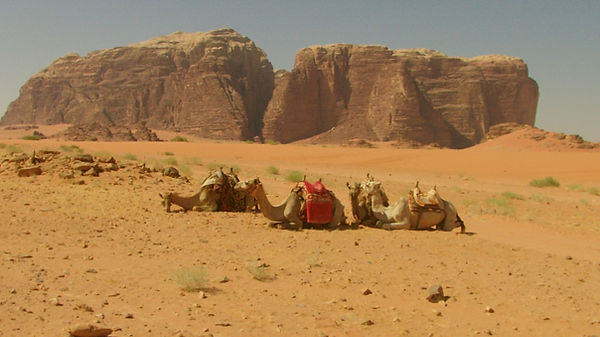
Wadi Rum
In the afternoon I climbed up into the hills and wandered by myself along a high rocky gorge where among the stones I found Spring in the desert - pallid meagre Spring which is all the desert knows. There were flowers, red and white and purple - we should scarcely notice them in our beflowered England, but here they seemed like separate jewels. Even the thorns were covered with greenish white seed bags which serve them for blossoming. And when I got to the top I looked out upon fold after fold of golden red sand and smoke grey rock, with the black tents of the Howaitat clinging to the slopes or nestled into the valleys. I longed for you to look with me - it was a sight that filled the eyes and satisfied, for a moment, even the most restless mind. Gertrude Bell, 1913
The Howeitat (Huwetat, Huwaytat, Howaitat)) Bedouins take a rather original stand among the Arabian tribes. From Egypt to Djof, from the Dead Sea until far down into the Hedjas they were feared as cruel warriors, and still a sort of stain was on them: their progenitor Huwet has not been a free Bedu, but an Egyptian. The Howeitat have been camel traders, bringing great numbers of these animals to Cairo. They became famous in Western civilisation through Auda Abu Tayi´s role in the riot of the desert, led by Lawrence of Arabia. Auda Abu Tayi led a life like a hero of the past. He was said to have slain 75 men in combat, man against man, without counting the Turks, whom he hated. He lived in permanent feuds and liked to recall his deeds in epic form like the old poets. Auda´s hour came with outbreak of World War One. In 1917 he led Sherif Naser of Medina and Lawrence across Wadi Sirhan to Akaba that could be taken from backwards by this way, leading to the decisive turn against the Ottoman empire. Nothing is known about the horse breeding of the Howeitat, but Gertrude Bell has left two photos of their horses. Interesting is that the Beni Sakhr, a neighboring tribe, name the “strain” Howeitiyah as one of Al Khamsa. Today the Howeitat make up the largest part of the inhabitants of the Wadi Rum area in Jordan.
.jpg)

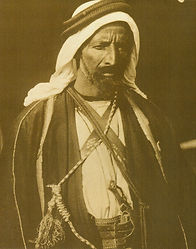
Quasin, son of Sheikh Harb of Howeitat, left, and Awwad´s son (in the desert near Tubayq, Saudi Arabia (Gertrude Bell 1914), Howeitat Bedouin by Carl Raswan, Auda Abu Tayi (photo by Lawrence of Arabia)
